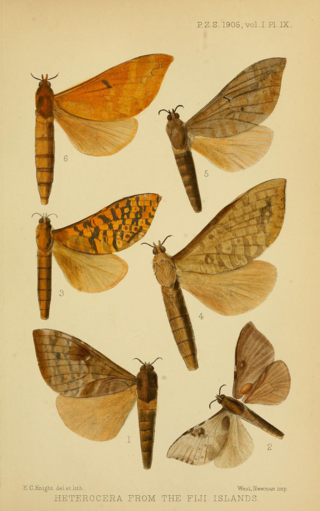Andeabatis is a monotypic moth genus of the family Hepialidae. The only species is Andeabatis chilensis of southern South America.

Phassodes is a moth genus of the family Hepialidae. As of 2018, it is monospecific, consisting of the sole species Phassodes vitiensis; this species is very variable. It is found in Fiji and Samoa. The life cycle is unknown but the larva is presumed to feed underground on the roots of plants or decaying matter.
Phialuse is a monotypic moth genus of the family Hepialidae. The only described species is P. palmar of Bolivia.
Puermytrans is a monotypic moth genus of the family Hepialidae. The only described species is P. chiliensis of Chile.
Callipielus fumosa is a species of moth of the family Hepialidae. It is known from Chile.
Cibyra foetterlei is a species of moth of the family Hepialidae. It is known from Brazil.
Cibyra indicata is a species of moth of the family Hepialidae. It is known from Ecuador.
Cibyra oreas is a species of moth of the family Hepialidae. It is known to reside in Brazil.
Cibyra paropus is a species of moth of the family Hepialidae. It is known from Ecuador.
Cibyra rileyi is a species of moth of the family Hepialidae. It is native to Brazil.
Cibyra sladeni is a species of moth of the family Hepialidae. It is known from Brazil.
Cibyra spitzi is a species of moth of the family Hepialidae. It is known from Brazil.
Cibyra trilinearis is a species of moth of the family Hepialidae. It is known from Colombia.
Cibyra verresi is a species of moth of the family Hepialidae. It is known from Brazil.
Ahamus anomopterus is a species of moth of the family Hepialidae. It was described by D.R. Yang in 1994, and is known from Yunnan, China.
Ahamus jianchuanensis is a species of moth of the family Hepialidae. It was described by Yang in 1994, and is known from Yunnan, China.
Ahamus luquensis is a species of moth of the family Hepialidae. It was described by D.R. Yang in 1995, and is known from Gansu, China.
Ahamus menyuanicus is a species of moth of the family Hepialidae. It was described by Hong-Fu Chu and Lin-Yao Wang in 1985 and is known from Qinghai, China.
Ahamus sichuanus is a species of moth of the family Hepialidae. It was described by Hong-Fu Chu and Lin-Yao Wang in 1985 and is known from Sichuan, China.
Ahamus yunnanensis is a species of moth of the family Hepialidae. It was described by D.R. Yang, C.D. Li and C. Shen in 1992, and is known from Yunnan, China, from which its species epithet is derived.
